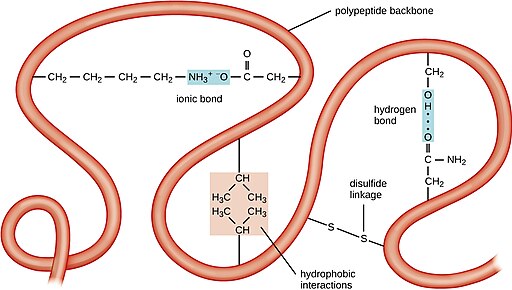Wrap-Up Questions
1. Figure 4 (reproduced below) shows the folding of a hypothetical protein, with noncovalent bonds holding the folds in place. An ionic bond between lysine and aspartate is shown.
Mutations can change the amino acid composition of a protein. What do you think might be the consequence of folding of a mutation that changed the negatively charged aspartate to a positively charged arginine?

2. Early on, molecular biologists hypothesized that, with 20 amino acids found in proteins and only four bases found in nucleic acids, the genetic code must use triplet codons. Triplet codons give 64 possible sequence combinations, which is more than sufficient to encode 20 amino acids.
- What is the maximum number of amino acids that could be specified by a two-base code? What is the maximum number of amino acids that could be specified by a four-base code?
- The process of transcription is energetically demanding for the cell. Explain why it would not be advantageous for cells to use a four-base code to specify 20 amino acids.
3. Figure 8 gives one version of a codon table, but other ways of presenting the information exist. Do a web search for “codon table” images. Compare 3-4 different versions of a codon table. What are some similarities and differences with how the information is presented? Which version would you personally find easiest to use?
4. There are 6 arginine codons, as shown in Figure 8. What is the minimum number of anti-codons necessary to recognize all six codons? What are their sequences?
5. Figure 16 shows the structure of a typical eukaryotic gene. Draw a similar diagram for a prokaryotic gene. In your diagram, include the -10 and -35 boxes, the +1 site, the terminator, the ribosome binding site, the start codon, and the stop codon. Which of these sequences is important for transcription? Which of these sequences is important for translation?
6. A simplified prokaryotic gene sequence is diagrammed below, with the -35, -10, +1, ribosome binding site, and terminator sequences underlined.
5’aaTTGACAactgtgtgatgtagcttaTATAATatgatgctaCgttaaAGGAGGtgggtaatgcctaaatggcggtaacgtgaGGCCGCGGCCTTTTcccc3’
- Is this the coding or noncoding strand of the DNA?
- Circle the start and stop codons for this gene.
- What is the sequence of the polypeptide that is produced from this gene?
7. The genes encoding tRNA can be mutated, just like any other gene. In some rare cases, the tRNA for Leucine has its anticodon mutated so that the AAU anticodon sequence is changed to AUU. What codon(s) will the new, mutated tRNA recognize? What do you think the consequence of the mutation might be to the process of translation?
Media Attributions
- OSC Microbio tertiary © Wikipedia is licensed under a CC0 (Creative Commons Zero) license

